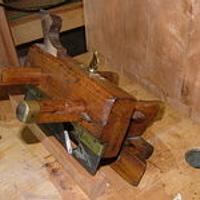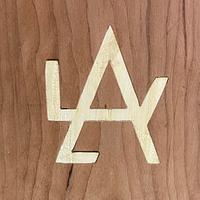
Oldtool
in about 3 years
Question regarding gluing veneer
I'm going to use Titebond 3, recommend by both Titebond and the veneer manufacturer. Reasons: wood on wood, plenty of time to straighten the wood grain, and should I create voids, I can reactivate the glue with hot clothing iron.
I've got two methods in mind, as I do not have a vacuum bag, and no large flat surface, so;
1. Glue in two sessions, half at a time on my 19" wide work bench, permitting weighting down with half of plywood supported off the bench.
2. Glue in one shot, on game room floor that has 6" X 6" tiles and grout lines, or maybe on top of area rug on tile, rug being about 1/2" thick and fairly firm, again with weights available - big artificial Xmas tree box, luggage, etc.
Am I way off base here?, anybody have better solution?
Thanks.
21 Replies
May you have the day you deserve!
Sorry but I think that it may be impossible to get even half of a 72x38" sheet and the substrate covered with TB3 or any PVA glues before it gets tacky. PVA starts to dry very quickly and that is a lot of area that you have to get evenly covered, get it in place, J-rolled and clamped flat. Sounds like a potential disaster to me. If you were talking about an area no larger than about 24x24, it might work but any larger and I think it is bound to fail. I've never tried them but Urea formaldehye glues may be a better choice than TB3 but also requires uniform clamping over the entire surface.
I am a little skeptical about the idea of reactivating the TB3 with an iron, if there is a spot that doesn't adhere. From my understanding, you will only get one shot at that. I've only every used heat to debond PVA glue and once it was heated, the glue was ruined and certainly would not readhere. I've seen a demonstration were you spread PVA glue on the veneer and substrate. Once the glue has dried, you lay it in place and iron it down. I have not tried it but the guy who demonstrated the technique said that if it doesn't adhere the first time, you cannot try heating it again. You get one shot at it. I would definitely experiment with the TB3 first with some cheap veneer on a practice piece.
I too have done hammer veneering with hot hide glue but doing that on a 72" long piece without experience might be a little challenging for a first attempt. With limited experience, I probably would also do it in strips narrower than the 38" as you have to get it "hammered down" before the HHG cools and gels. Hammering is soft like using a hard squeegee to press out the the excess glue underneath the veneer and requires no clamps, cauls or weight on top. Probably not the technique you want to try for the first time on such a large project but it is a great way to apply veneer.
--Nathan, TX. Hire the lazy man. He may not do as much work but that's because he will find a better way.
Thank you all for your input, your experience & knowledge will give much to think about while I finish the trim & ornamentation on this.
Anyway, I definitely don’t know the answers, and while she would like to have the new tabletop sooner, we don’t have anyone visiting until next spring, so I’ve got at least that long to figure out my technique and clear enough space to set up the sawhorses and such in the shop. Plus it’ll be too cold outside for hot-hide-glue soon, so I can work on smaller practice pieces over the winter. Simply getting space to work on a 60” piece of wood (it’s a 5 foot square of ¾” cabinet-grade plywood, so I don’t want mistakes there, either) is a challenge most days.
To give you an idea of what I’ve tried and rejected so far, I tried TB2, which has a pretty good open time. But I had problems with it oozing through porosities in the veneer and gluing the veneer to my clamping cauls, even after treating them with wax and/or packing tape.

I tried with TB hide glue (which has a longish open time, especially if you thin it) and had problems with the veneer creeping as I clamped it. At least that I could remove by soaking the veneer with water and hitting it with a heat gun to soften things up, and I could reuse the piece of veneer.

The little practice box has taught me a TON so I strongly recommend working on smaller pieces first to figure out what works for you. I’m planning a 2’ circular table, or maybe a round box next, which I’ll veneer with four pieces of veneer, each a quarter-circle, which will get me experience butting the seams together that I’m going to need for the center of my table-top.
I encourage you to stick with the idea of veneer, Tom, because then you can learn stuff that might help me, too. ;-)
May you have the day you deserve!
Figuring out how to do something you have never done is what makes a good challenge.
One of the nice things about hammer veneering with hot hide glue is that it is completely reversible if you screw it up. Heat and moisture will soften the glue and you can re-hammer it down and you can do it as many times as necessary. You can even completely remove it and start over. I simply wet the spot and place a wet rag over it and used an old cloths iron to reactivate the glue so that I could re-hammer. I think the key to being successful on this panel would be to cut the veneer into narrower strips -- 4-6". You just need to make sure that the edges are nice and straight. If the veneer is thin enough you can use a utility knife and straight edge to get nice straight lines. Just becareful that you don't let the knife follow the grain as you cut. The length is also a concern but as long as the temperature is not too cool (you can warm the substrate with a heater before you apply if necessary), with narrower strips , I think that it would be doable based upon my experience.
Of course you have to get a way to heat your glue and get or make a veneer hammer but you can use a crock pot and there are several examples around for making your own hammer. I learned most of what I know about the technique from Shipwright's blogs on Lumberjocks, though they screwed up the blogs so badly during their conversion that they may be follow now. Not sure if he has also posted them here.
This was my first hammer veneering project. The veneer I bought was in 5 or 6" strips and as you can see were cut into relatively short pieces. The most challenging part was the interior ring. I cannot imagine trying this with any other technique, especially as a first attempt. Contact cement would have been really difficult on this project as would have other veneering techniques. Hide glue actually made this pretty easy.

--Nathan, TX. Hire the lazy man. He may not do as much work but that's because he will find a better way.
May you have the day you deserve!
Regarding contact cement; first - I'm afraid of the fact that once it touches down, "you pretty much have to go forward." as Lazyman says, and I know from my experiences I'll never touch down where intended. Second - the smell is a killer. I helped a neighbor once years ago, who needed me to attach via a lap joint two sections of quarter inch ply for his new bay window sill, using his wood & his glue. I understand now why he wanted it done in my garage, my wife complained about the odor for a week.
Dave and Lazyman, you both mentioned using thin strips on a large surface, and I think you guys are on to something. The veneer I have was peeled from one cherry log that resulted in a repeating pattern of what looks like vertical boards side jointed, and as Lazyman suggests, I can cut it in strips with a razor knife. It's only about an eighth inch thick, and cut straight or not, the strips will match when assembled in the same order. I'll try to pick a section that looks like a board joint, and I'll need some working time for realignmen, so I guess it's just a matter of glue selection.
Thank you Dave, Lazyman, and Bentlyj, I'll post the bookcase project with the veneer details included. Right now, I'm finishing the molding trim, have time to think about glue.
I never use the water base, but it should be perfect for your application.
If you wanted to use it, I could give you some tips with pictures so you could stick it perfect first time. Let me know if you change your mind.
It's definitely easier than cutting strips and trying to put them back together.
Figuring out how to do something you have never done is what makes a good challenge.

and I'll need some working time for realignmen, so I guess it's just a matter of glue selection.
I liked working with the TB Hide Glue, but its open time was longer than I needed. Hot hide glue has been best for me, because of its relatively short (but controllable by dilution and heat) open time, so I don’t need to clamp anything, but can just keep pressing the joint together by hand until e glue has cooled enough to set.
Might be you’ll work differently and find a different answer, but if you are going to try hot hide glue, I would recommend the BT&C hide glue granules in either the 192 or 251 gram strength. The Piggly No Wiggly glue from The Schwartz has a gram-strength of 250, and is another good choice. I prefer the granules, as I don’t have any worries about them aging until I mix up a batch, but pre-mixed is definitely easier if you know you’re going to use it relatively quickly.
May you have the day you deserve!
The video that convinced me to try hammer veneering for the mirror I posted above was this video by Shipwright (with plenty of advice from him as well). It really is as easy as he makes it look. That doesn't mean that it doesn't take some practice but for smallish projects, it doesn't take a huge learning curve.
--Nathan, TX. Hire the lazy man. He may not do as much work but that's because he will find a better way.
I know that depending on the woods and dimensions, when you go big you really need to use the proper glue or changes in expansion can cause the veneer to crack and do other undesirable things.
Contact cement, as a process, can be laid easily enough when treated like laminating a counter top (use slats to elevate the laminate, position, then remove slats from the middle outwards).
Without hammering, a vacuum bag, or other flat, high pressure clamping method you are destined for a lumpy surface.
Paul (Shipwright) certainly is the go to help desk guy here.
Dave,
TBII has that bright yellow color that makes for hiding squeeze through nearly impossible. The viscosity is also way too much IMO.
I have had success for controlling squeeze through by eventually learning how much glue is enough. Before then with waxed cauls, I'd lay two layers of paper towel between the caul and veneer before pressing. The paper absorbs the squeeze versus having it ooze across the veneer surface. Sure, the paper will adhere to the pores where the glue comes through, but a quick scraping easily removes that and no dealing with the embedded mess of a fingerprint size glue stain to deal with.
I know that depending on the woods and dimensions, when you go big you really need to use the proper glue or changes in expansion can cause the veneer to crack and do other undesirable things.
From my research I found that its rigidity is actually one of the properties of hide glue that make it great for veneer. When it dries, it is rock hard and experiences no creep. From my research, I read that its rigidity is also what makes urea formaldehyde another good option for veneer. PVA glue is very flexible in comparison, and contact cement is even more so, and the flexibility can eventually lead to issues, especially with wood veneer on horizontal surfaces like table tops. That is probably not as big of an issue in the vertical context for this project.
--Nathan, TX. Hire the lazy man. He may not do as much work but that's because he will find a better way.
In the video on the link you posted, he said that he came up this idea after wondering if Gummi Bears could be used as a glue. The answer was yes. I may have to see what that is like. 😀
I also like the idea of making my own but of course they didn't share the ratio of salt to gelatin that they use. I suppose you could make it just like mixing up a batch of HHG and not have a shelf stable liquid version.
--Nathan, TX. Hire the lazy man. He may not do as much work but that's because he will find a better way.
TBII has that bright yellow color that makes for hiding squeeze through nearly impossible. The viscosity is also way too much IMO.
Yep. But TBII can be thinned with water, which is how I generally have used it for veneering. The downside is that thinning it lengthens the open time.
Does it act like liquid hide glue or does it have a gel point like HHG does?
More like liquid hide glue, so it doesn’t have the quick gel that makes HHG work so well. That said, it’s not a bad glue to have on hand. I’ll be replacing my fish glue with Piggly No Wiggly once I’ve used it up or had it go bad.
May you have the day you deserve!
I'm still thinking about type of glue to use, will study all your comments above as well as the videos provided, and any YT videos I come across. One thing for sure, per suggestions prior mentioned, I'm going to cut the big sheet into 3 strips for ease of handling. Studying the veneer, I've found 3 places where it looks exactly like a multi-board glueup. I'll do one at a time letting the glue dry for 24 hours, three days in a row.
Thanks for all the comments.
https://www.joewoodworker.com/veneering/faq-veneer-glue.htm
https://www.joewoodworker.com/veneering/glues.htm













